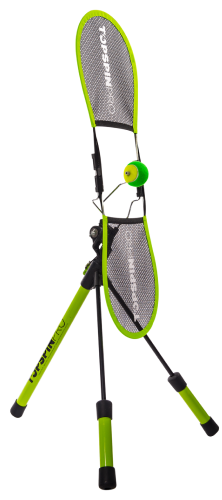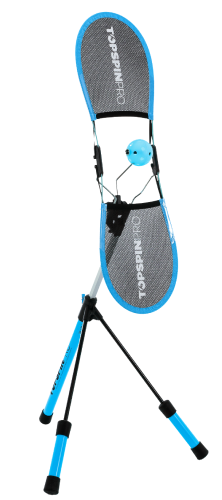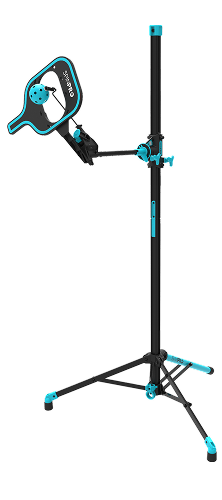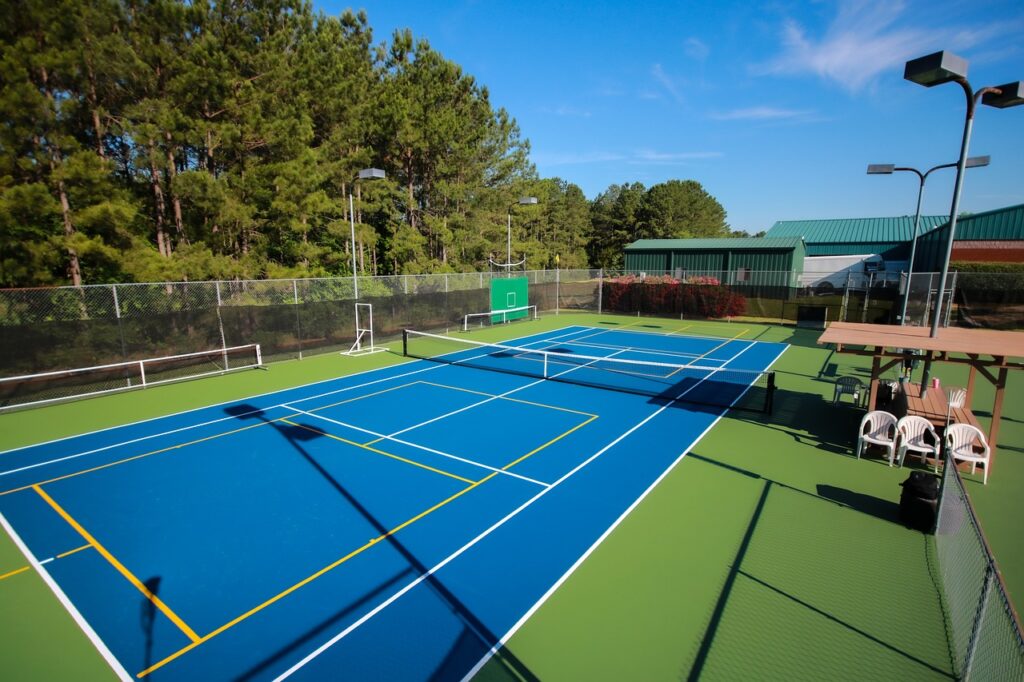 Photo: pixabay.com
Photo: pixabay.com
What we'll cover in this article:
Stay in the loop!
Want to be updated when we publish? Be sure to sign up for our newsletter. No spam, we promise!
Tennis vs Pickleball
History
The modern game of tennis originated in England during the late 19th century. Initially known as "lawn tennis," it was played on grass courts, and the sport quickly spread across the globe.
Pickleball is a relatively new sport, invented in 1965 on Bainbridge Island, Washington, by three fathers – Joel Pritchard, Bill Bell, and Barney McCallum. The game was a result of improvising with available equipment to entertain their children.
Equipment
1. Tennis Vs Pickleball Court Size
The tennis court is a significantly larger size at 78 x 36 ft for doubles with service boxes. The pickleball court is at 20 x 44 ft with a unique "kitchen" area (the non-volley zone). You can generally fit 4 pickleball courts on one full size tennis court area.
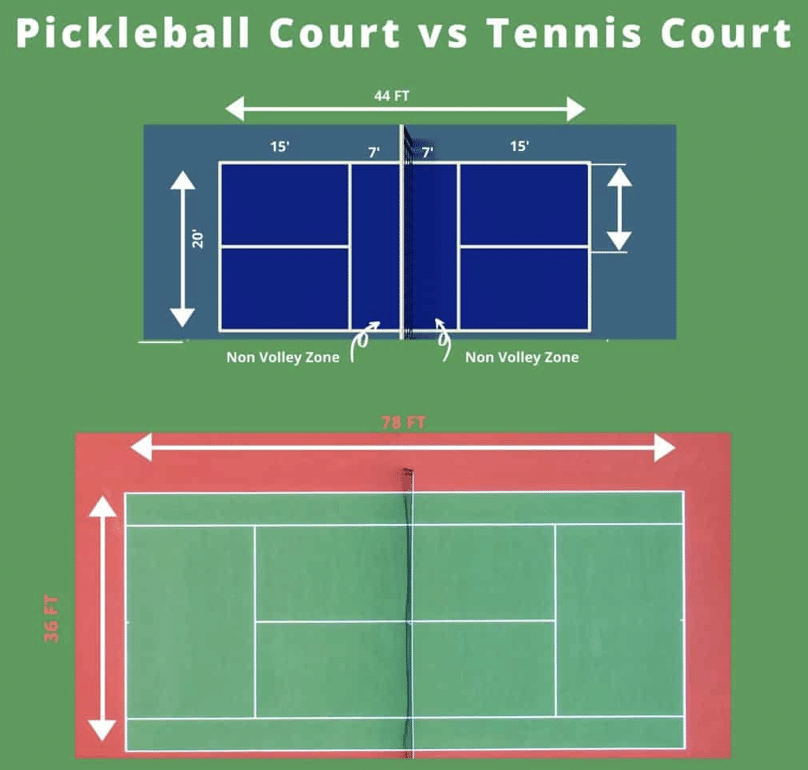
2. Tennis Vs Pickleball Court Surface
The surface varies more in tennis. Hard, clay, grass and carpet are all commonly found types of court. You can read our in depth article for more info: Tennis Court Surface: Exploring the Differences and Their Effects on Playing Style.
Pickleball is played mainly on hard courts (both outdoors and indoors).
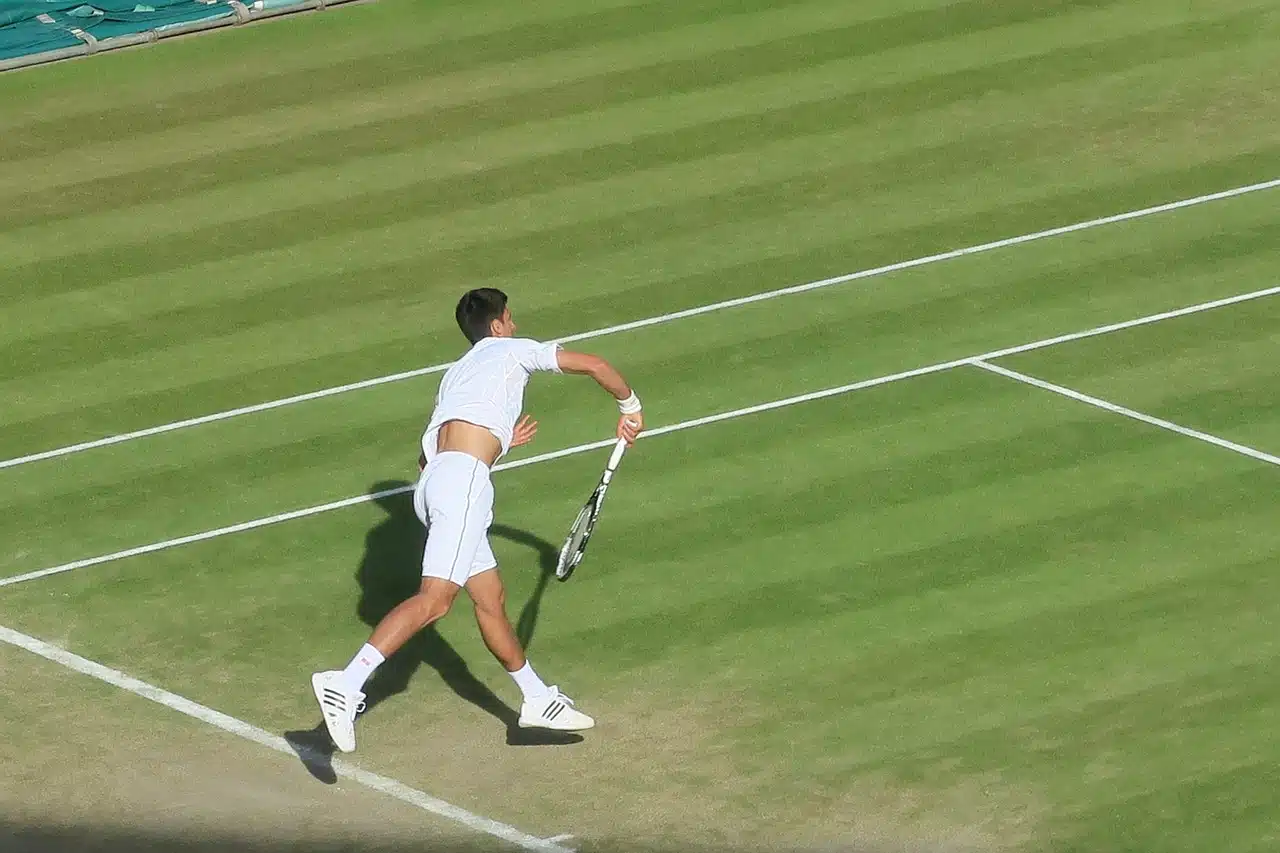
3. Tennis Vs Pickleball Net Height
The tennis net is a little taller with a measurement of 36 inches at the center vs 34 inches for a pickleball net.
4. Tennis Vs Pickleball Ball
A tennis ball is significantly heavier than a pickleball. The rubber interior causes it to bounce higher and faster than a pickleball, making it far more suitable for the larger tennis court size. The fluffy exterior also helps with generating spin. A pickleball is similar looking to a wiffle ball, with holes. Because the ball is made of plastic, it doesn’t bounce as fast or as high as a tennis ball.
5. Tennis Racket Vs Pickleball Paddle
The noticeable difference here is the size with a tennis racket being significantly bigger. The strings of the tennis racket flex when the ball makes contact making it much easier to generate power. The strings also provide more friction and a larger surface area for the ball to travel so it is much easier to impart spin on the ball. The extra length of the tennis racket also helps with reach and power needed for the larger court size. It would be hard to keep the ball in play if pickleball were to be played with a tennis racket!
Rules Of The Game
1. The Scoring System
Tennis is a longer format game. A match can last anywhere between 1 and 5 hours! A point system of love (0), 15, 30, 40, and game is used. Players must win by two points to secure a game. A set usually goes up to 6 games, and matches can be best of 3 or 5 sets depending on the format.
Pickleball matches are much shorter. Points are scored by the serving side only and are most often played to 11. Like tennis, players or teams must win a game by two points and matches are usually best of 3 or 5 games.
A lot of players when new to pickleball struggle with the complex scoring. Here's a video to give you some tips:
2. The Double Bounce Rule
Pickleball has a double bounce rule, in that the ball must bounce one time on each side of the court after the server has struck the ball before any player can volley. This rule is unique to pickleball.
3. Serving
When serving in tennis the ball must not make contact with the ground before you strike it. You can serve overhead or underhand.
In pickleball you must not make contact the with ball above waist height and it must be in an upward trajectory. You also can serve using a bounce or no bounce before striking. When using a bounce the above rules do not apply and the ball may bounce as many times as you like before struck. More than once is not recommended due to the low bounce of the ball!
4. The "Kitchen"
In tennis, you may volley the ball from any area of the court. In pickleball there is an area called the non-volley zone or "The Kitchen". You may not be standing in this area at anytime when volleying. You may also not step into this area throughout the entire action of the volley. So if you fall forward after you volley the ball and land in the kitchen, you will be called for a fault!
Playing Techniques
Due to the larger court size and equipment which suits more pace and spin, tennis allows for powerful groundstrokes, serves, and volleys. Spin, speed, and placement are crucial elements in tennis strategy. Utilizing the larger court space and opening up gaps is a crutial part of the game. Due to the larger court size, players often have to cover more ground, making endurance a significant factor.
Because of the smaller court size and the non-volley-zone (the kitchen) pickleball combines elements of tennis, badminton, and table tennis. Dinking (a soft shot) in pickleball is as important as a powerful smash. Patience is crucial as much of the game is about waiting and creating the right moment to attack. There are also much larger tempo swings than in tennis, which tends to be fast-paced most of the time. Pickleball can go from soft dinks to power speed-ups in a matter of seconds! This demands quick reflexes and shorter bursts of speed, especially during net exchanges.
Accessibility
Part of the meteoric rise of pickleball over the last few years has been its accessibility. Much of pickleball is played as a "drop In" style, where you don't need a partner. You just show up at your local courts with your paddle and play with whoever is there and in line for the next available court.
Because of the slower ball bounce and the size of the courts, pickleball is also far easier for beginner players to pick up, making it more accessible for a wider range of players. The investment in local and national tournaments that are amateur friendly also adds a community feel to the sport.
For those who are not new to the sport, tennis courts are still far more readily available than pickleball. It is also more accessible at the intermediate level where many lessons and clinics take place in local venues.
Cultural Impact
Tennis has had a profound impact on sports culture for over a century with Icons like Serena Williams, Roger Federer, and Rafael Nadal inspiring the next generation of players.
Pickleball is yet to have the same global reach as tennis, but pickleball's community-driven nature fosters a strong sense of camaraderie. The sport's grassroots growth ensures a tight-knit community feel and is responsible for its surge in popularity over the last few years.
TOPSPINPRO BEGINNER COURSES
We use the latest neuroscience in our TopspinPro Online Courses. Check them out for some in depth help with developing your shots:
Conclusion
While tennis and pickleball share some superficial resemblances, they are distinct in equipment, gameplay, and strategy. Tennis, with its long history, has a global presence and cultural significance. Pickleball, on the other hand, offers an easy-to-learn, community-focused alternative that's gaining traction rapidly. Regardless of the differences, both sports offer a fantastic blend of physical exercise, strategy, and social interaction with many skills being transferable to both sports.
FAQs
-
What are the origins of tennis and pickleball?
Tennis originated in England during the late 19th century as “lawn tennis” and quickly spread globally. Pickleball was invented in 1965 on Bainbridge Island, Washington, by three fathers who improvised to entertain their children.
-
How do the court sizes for tennis and pickleball compare?
A tennis court for doubles measures 78 x 36 ft, whereas a pickleball court is 20 x 44 ft. You can generally fit four pickleball courts on one full-size tennis court area.
-
What are the main differences between tennis and pickleball equipment?
Tennis uses a heavier rubber ball with a fluffy exterior for spin, and a larger racket with strings for power and reach. Pickleball uses a plastic ball with holes and a smaller paddle, making it suitable for the smaller court and unique gameplay style.
-
How do the scoring systems differ between tennis and pickleball?
Tennis matches can last 1 to 5 hours with a point system of love (0), 15, 30, 40, and game, requiring players to win by two points. Pickleball matches are shorter, scored by the serving side only, typically played to 11 points, and also require a two-point win.
-
What makes pickleball more accessible compared to tennis?
Pickleball’s smaller court size and slower ball bounce make it easier for beginners, and the “drop-in” style of play allows players to join games without a partner. Its community-driven nature and amateur-friendly tournaments add to its accessibility and growing popularity.
Enjoyed this article?
Be sure to sign up for our newsletter and we'll keep you up to date about new posts
